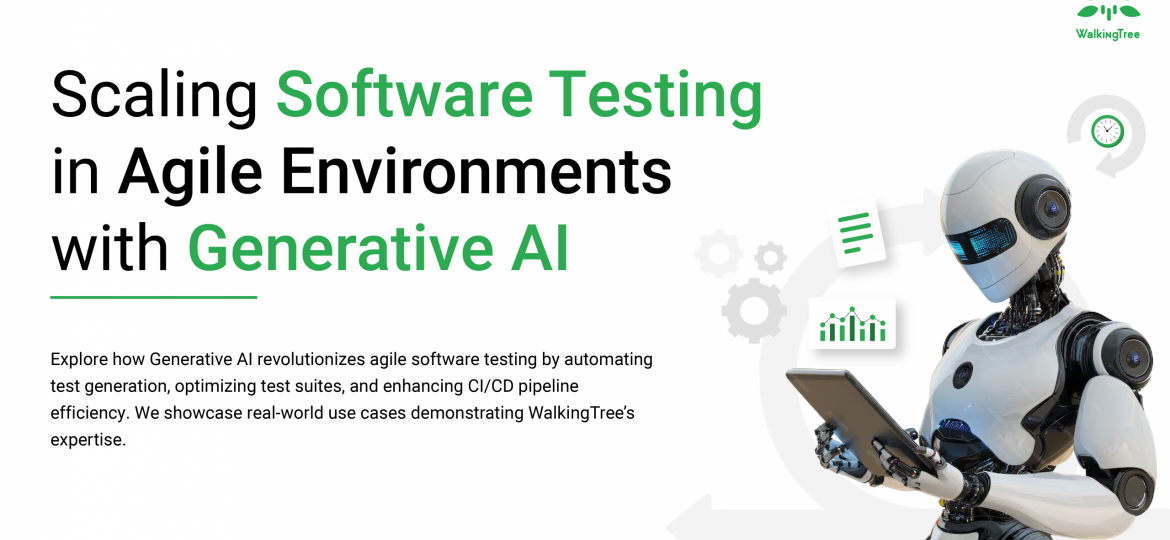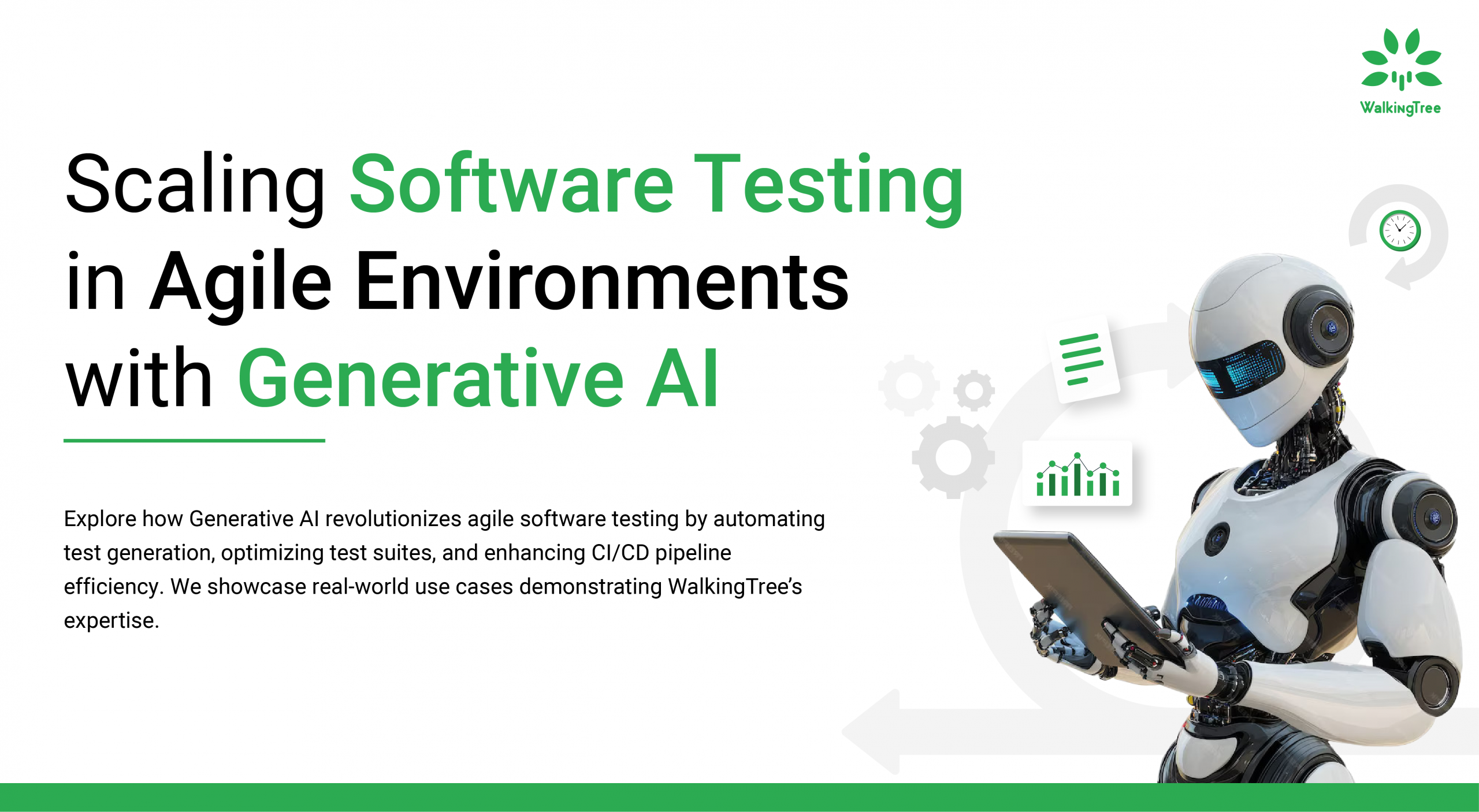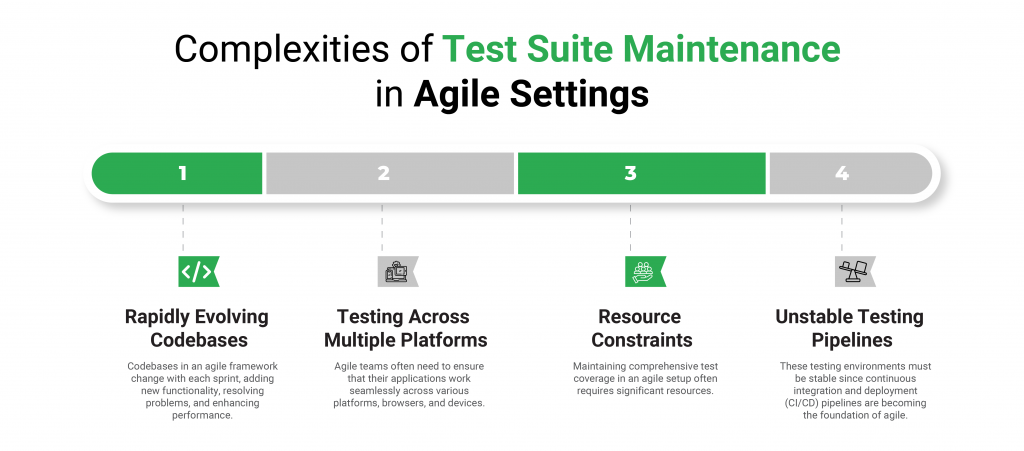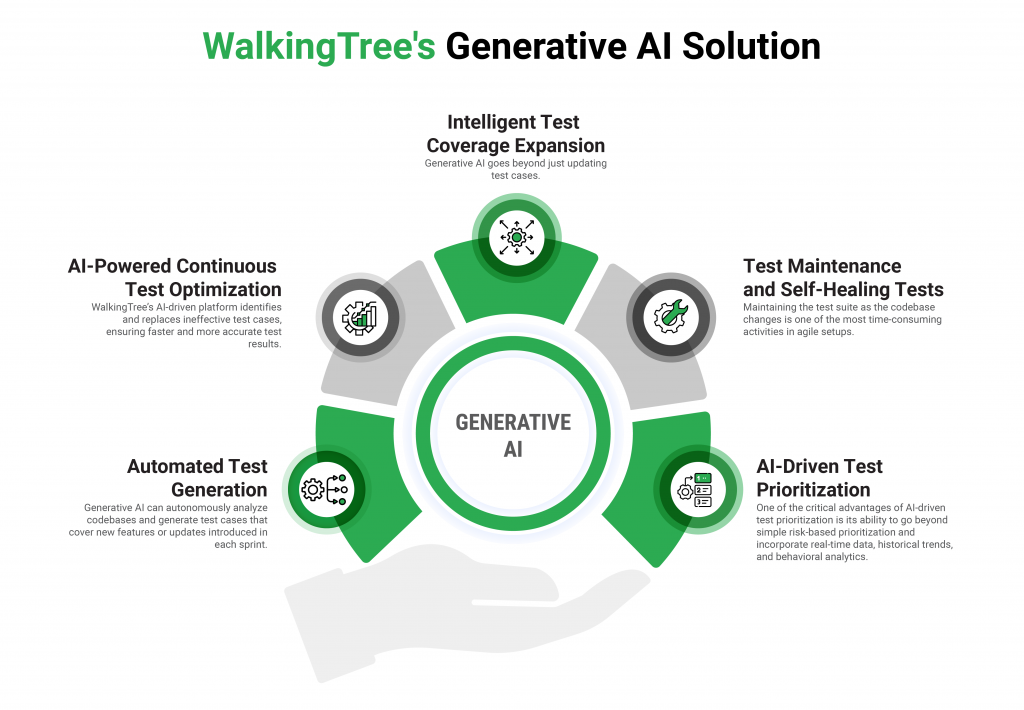
Across all industries, organizations are now embracing agile methodologies to speed up their software development cycles but this introduces a problem: how can you maintain the stability and quality of codebases that change so frequently? The demand to continuously release new functionality and innovations results in a complex, fast-changing environment that slows down traditional testing processes. Test suites become stale fast, or inadequate, which can introduce production risks.
WalkingTree’s AI-powered solutions, especially through its TAP platform, are designed to address these challenges by leveraging Generative AI. It automates the refinement of test cases, optimizes testing strategies, and delivers real-time insights to ensure more dependable, faster releases. By doing so, agile teams can maintain the highest quality standards, scale their testing processes, and remain competitive.
|The Challenges of Maintaining Test Suites in Agile Environments
Agile environments thrive on continuous development and delivery, emphasizing speed and iteration. While this approach leads to faster product updates and better alignment with market needs, it introduces significant challenges in testing.
- Rapidly Evolving Codebases: Codebases in an agile framework change with each sprint, adding new functionality, resolving problems, and enhancing performance. To guarantee that recently added functionalities are covered while controlling regression, test cases must be reevaluated at each iteration.
- Testing Across Multiple Platforms: Agile teams often need to ensure that their applications work seamlessly across various platforms, browsers, and devices. With each platform update, the test suite needs to accommodate new compatibility requirements, adding complexity to the testing process.
- Resource Constraints: Maintaining comprehensive test coverage in an agile setup often requires significant resources. Manual testers, automation engineers, and infrastructure must align continuously to ensure that the testing process does not become a bottleneck in the development cycle. When teams are under pressure to meet tight deadlines, this alignment can break down.
- Unstable Testing Pipelines: These testing environments must be stable since CI/CD pipelines are becoming the foundation of agile. But as features change, tests may become antiquated, faulty, or ineffective, creating unstable pipelines that need ongoing upkeep.
These challenges underscore the need for a more dynamic and intelligent testing approach that can evolve with the software itself. This is where Generative AI steps in.
|How WalkingTree’s Generative AI Helps Agile Teams
WalkingTree’s AI solutions automate test generation and continuously improve test quality. By integrating these tools, agile teams can overcome traditional testing challenges and meet the demands of rapid development. By leveraging these AI capabilities, organizations can continuously update and expand their test suites, ensuring that they reflect the latest changes in the system without human intervention
- Automated Test Generation: Generative AI can autonomously analyze codebases and generate test cases that cover new features or updates introduced in each sprint. This reduces the burden on developers and testers to manually write and update tests, ensuring better coverage with minimal effort. AI models, such as WalkingTree’s Test Automation Partner platform, analyzes the user stories and generates test cases that align with the latest requirements.
Example: Instead of developers manually writing tests for each new feature, WalkingTree’s platform uses AI to analyze requirement changes, automatically generating appropriate test cases that cover all functionalities, whether in mobile apps, APIs, or web platforms.
- AI-Powered Continuous Test Optimization: WalkingTree’s AI-driven platform identifies and replaces ineffective test cases, ensuring faster and more accurate test results. This reduces the burden on developers and keeps testing pipelines stable and reliable.
Example: In a FinTech project, self-healing tests were employed to automatically adapt to changes in both UI and backend logic. WalkingTree’s solution helped the client achieve a 50% improvement in pipeline stability and reduced the need for manual intervention.
- Intelligent Test Coverage Expansion: Generative AI goes beyond just updating test cases. It can identify areas in the code that have not been adequately tested, such as edge cases—unusual situations or inputs that are not part of the standard, day-to-day use of an application but could still occur under certain circumstances. Edge cases often push the system to its limits and can reveal bugs or weaknesses that would otherwise go unnoticed.
Example: A global SaaS provider leveraged WalkingTree’s TAP to automatically generate test cases for previously uncovered areas, enabling faster release cycles with improved product reliability.
- Test Maintenance and Self-Healing Tests: Maintaining the test suite as the codebase changes is one of the most time-consuming activities in agile setups. Self-healing tests are automated tests that can automatically adapt to changes in the application without requiring manual updates by the tester. When elements in the user interface (UI) or the underlying system change, the AI detects these changes and adjusts the test scripts accordingly, ensuring that tests continue to run smoothly.
Example: For a fintech client, when UI elements were moved or renamed, the system automatically updated the test cases. This resulted in significantly reduced test maintenance and increased release efficiency.
- AI-Driven Test Prioritization: One of the critical advantages of AI-driven test prioritization is its ability to go beyond simple risk-based prioritization and incorporate real-time data, historical trends, and behavioral analytics. Instead of only considering code changes, WalkingTree’s platform uses AI to prioritize tests based on recent code changes, historical test results, and high-risk areas. By focusing on the most important tests, teams can catch critical bugs faster, reducing overall testing time.
Example: WalkingTree’s predictive analytics platform helped a telecom company prioritize testing for high-risk areas, reducing bugs in production by 35%.
|Scaling Testing in a CI/CD Pipeline
In agile environments, Continuous Integration (CI) and Continuous Delivery (CD) pipelines are vital to ensuring that code is integrated, tested, and deployed frequently, without delays or disruptions. However, the true effectiveness of these pipelines hinges on the reliability and scalability of the tests running within them. As projects expand and new features are added, maintaining a robust test suite becomes a significant challenge.
Frequent changes in code, new feature deployments, and bug fixes can cause test suites to become outdated or incomplete. Traditional methods of testing—such as running the full test suite for each new build—slow down CI/CD pipelines, making it difficult to keep up with the rapid pace of agile development.
WalkingTree’s Generative AI-driven solutions provide a smarter, more scalable approach to testing within CI/CD pipelines. By leveraging machine learning techniques and predictive analytics, WalkingTree’s AI generates the automated test cases, selects and prioritizes the most important tests for each code change, optimizing the test execution process and enabling faster feedback loops.
The Power of Continuous Testing in CI/CD Pipelines
Continuous Testing is a key practice in CI/CD pipelines, ensuring that every code change is tested as soon as it’s committed. It’s critical for maintaining quality and preventing regressions, but the increasing complexity of applications often creates a bottleneck. Running a complete test suite for every code commit becomes impractical as the project grows, leading to slower pipeline execution times and delayed feedback.
WalkingTree’s Generative AI solution transforms the testing process by automatically selecting the most relevant tests based on the latest code changes. The AI analyzes:
- Code dependencies to identify areas most likely to introduce defects.
- Historical test performance to prioritize tests that are most effective at catching issues.
- Real-time data to detect risky areas of the application that need immediate attention.
This means that instead of running the entire test suite, only the most critical tests are executed, reducing pipeline completion times and accelerating release cycles.
|Real-World Use Case: Agile Test Optimization with Generative AI at WalkingTree
1. How Generative AI Reduced Test Maintenance by 60% for a Global E-commerce Platform
A multinational e-commerce business was having trouble keeping up with the rapid addition of new features for various platforms and devices. The rate of development was too rapid for their test suite, which resulted in inadequate test coverage and a high frequency of defects reaching production.
WalkingTree implemented a Generative AI-powered testing framework that automatically generated test cases for new features as they were added to the codebase. The AI-driven system detected changes in real-time, creating and executing relevant tests for web, mobile, and API functionalities. This resulted in a 60% reduction in test maintenance time, enabling the team to focus on feature development rather than fire-fighting bugs.
2. How Self-Healing Test Suites improved CI/CD efficiency for a leading fintech company
A leading fintech company managing online financial transactions faced challenges due to the dynamic nature of its platform. Constant updates in the UI and backend led to frequent test failures and delays in their CI/CD pipelines.
We implemented a self-healing AI framework that allowed test cases to automatically adjust to changes in both the UI and backend. For instance, when a button was moved or renamed, the AI recognized this change and automatically updated the test cases without human intervention. As a result, the company saw a 50% improvement in pipeline stability and a drastic reduction in manual intervention for test updates.
3. Scalable Test Automation for a Cloud-Based SaaS Provider
As their user base increased, a SaaS provider of cloud-based HR management platforms encountered problems growing their testing activities. Releases were being delayed and expenses were rising due to the slowness and resource requirements of manual testing.
By leveraging WalkingTree’s TAP, the client was able to automatically generate test cases for new features and continuously optimize their test suite based on real-time user feedback and platform analytics. Our QAOps solution also helped integrate these tests into their CI/CD pipelines, providing automated regression testing. This resulted in a 40% faster release cycle, enabling the client to meet customer demands more efficiently.
4. Predictive Test Case Generation for a Telecom Giant
A leading telecom provider faced challenges in keeping up with the fast-paced updates required to support new features, security patches, and device compatibility. The manual test creation and maintenance were slowing down their ability to release updates promptly.
Our team implemented a Generative AI-driven predictive analytics platform that could analyze past-release data, identify high-risk areas, and generate test cases accordingly. The platform dynamically adjusted to new updates, creating and prioritizing test cases that aligned with high-impact areas. This led to a 35% reduction in the number of bugs that made it to production, improving overall customer satisfaction and significantly reducing testing overhead.
At WalkingTree, we have harnessed the power of Generative AI to streamline testing processes across multiple agile projects. Our platform, powered by TAP (Test Automation Partner), uses AI to continuously analyze the system and propose test optimizations that reflect the latest product changes. This has been particularly useful for clients with complex microservices architectures, where the interaction between different services requires intricate testing scenarios that are difficult to maintain manually.
By integrating this generative AI-powered platform with existing CI/CD pipelines, our clients experienced faster feedback loops and increased confidence in their deployments. Automated regression testing became more reliable, ensuring that critical business functionalities were not inadvertently affected by new updates.
|Conclusion
As generative AI continues to evolve, the future of agile testing will likely see even greater automation and efficiency. AI-driven insights will help development teams predict potential issues before they occur, while AI-powered test generation will ensure comprehensive coverage without the manual overhead. In agile environments, where time-to-market is critical, the ability to scale testing effortlessly will become a competitive advantage.
We at WalkingTree are pioneering this change. We enable enterprises to extend their software testing activities using state-of-the-art technology thanks to our proficiency in agile development, DevOps, and AI-driven solutions. Regardless of how quickly your code changes, our AI-powered platforms—including our in-house QAOps solution—make sure your test suites stay flexible, effective, and dependable.
With AI-powered platforms like QAOps and our TAP framework, your business can automate time-consuming processes like UI testing, test data generation, and test suite optimization. This not only speeds up your CI/CD pipelines but also ensures that your software releases are more dependable and aligned with fast-changing market demands. The result? Faster delivery, improved quality, and a testing process that can scale effortlessly as your projects grow.
Are you ready to transform your software testing processes with generative AI? Watch our exclusive webinar recording on “Scaling Software Testing in Agile Environments with Generative AI” . Discover how to transform your testing process with AI-driven platforms. Learn practical strategies to accelerate release cycles, improve coverage, and minimize risks—all while maintaining high software quality.
Contact us and take the next step toward scalable, AI-driven test automation that meets the demands of your agile environment!


